Our Natural Fiber Cottage Industry
MOHAIR IS OUR UNIQUE CRAFT RESOURCE. It is natural, sustainable and renewable - from ancient times until now
Twice a year the angora goats are sheared of their long, lustrous coats of mohair. The best fleeces are bagged, marked and put aside. The animals produce such a lustrous, durable fiber that even after many years of clipping the hair we still marvel at it's beauty- ooooing and aahhhing as the tendrils come off. Our critters are kind of spoiled and don't get the same treatment commercial outfits give their goats. (Though most value their animals very much). Ours pretty much just stand there and let us shear. We are so near them and handle them so much they know we aren't going to hurt them. The little kids catch on quick . I give them a handful of grain now and then as we shear. There are a few though that are just plain old ornery.
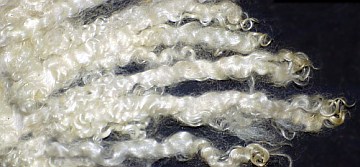
Pure bred angora goat mohair
These are how the tendrils appear once they are shorn. A good staple length is anywhere from 6 to 8 inches in a six month period. The dark tips are the result of exposure to the elements of nature . The cleaning process removes pollen, dust and most organic debris but the sun, wind and rain form a permanent alteration of the fiber. Most large fiber industries treat the fibers with various acid rinses and bleaches to standardize the color and condition of the fibers. We do not do this except when we change the color of the fleece all together by dying it. We have been advocates of caution for a long time when it has come to the use of industrial grade chemical applications on any aspect of our operation and in particular the herd and its mohair.
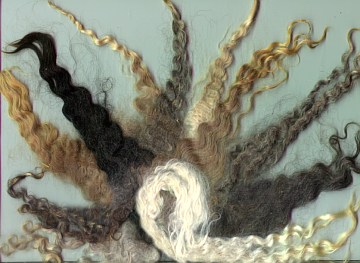
Various colors and crimp styles
These are the types of color and "crimp" textures that commonly come from the angora goat. The samples are called "locks". Adult angora goat hair usually opens up and takes on the character of an "open lock". Often appears like human hair and is used as doll hair by many professional and hobbyist doll makers. Some excellent examples can be found here. We sell a lot of our mohair to doll makers and hobby retailers. The kid goat and yearling goat hair is extremely fine and is much coveted among hand spinners for use in garments. Alexandra is very covetous of her kid hair harvest. She especially enjoys spinning and weaving it. The first shearing of the young angora kids is incredibly soft and highly prized among fiber enthusiasts and discriminating garment purchasers.
Nature has gifted these capricious creatures with the ability to produce luxuriously soft and durable fibers to keep warm. When the growing season is through they greatly enjoy being divested of their long tendrils. "Thank you!" "No, but thank you!", we say. It is back breaking work bending over the goats to clip their fiber. But it is very rewarding to see the valuable harvest. Their must be special care taken not to cut the skin with the cumbersome clippers. The hide is very tender because of the mohair shield that has covered the goat from the harsh extremes of nature.
The process of harvesting mohair begins with a 6 to 8 month wait for the fiber to grow. A productive angora goat will produce an inch of mohair per month. The sequence of images below is of the original "Mo" from our Montana herd(1980-1991)being shorn.
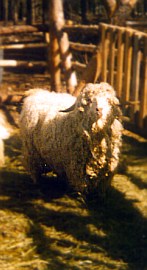 |
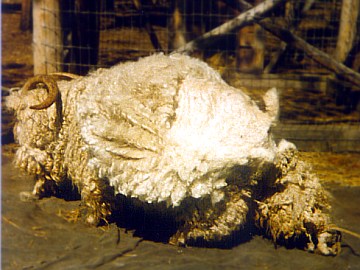 |
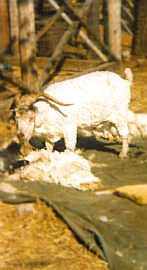 |
Here Mo is being stripped of his brilliantly shining and durable fleece (center). Mohair comes in a multiplicity of "grades". Sheen is of utmost importance to us. It gives mohair one of it's diamond characters. This particular method of shearing is not "professional" but it works well for me with this big buck. His horns and his right rear leg are tethered. I don't like wrestling them down until it's absolutely necessary. I begin at the top of the goat, near the tail. By the time I get to the underside of the animal it realizes I mean him no harm. In fact he begins to breath a sigh of relief as the burden of his coat comes off during the warm Spring days. They squint their eyes and bask in the warm solar glow. Plus they get to scratch that itch they haven't been able to reach for some time. Mmmmmmm.
Usually the fall shearing takes place in warmer weather. Once that heavy coat is taken off they generally feel relieved of a heavy hot burden.The adult mohair is often used as doll hair and resembles human hair very much. Not long ago mohair was the standard material used to create wigs. The bundles of fiber surrounding Mo on the shearing cloth (image on the right side of the panel) are called tags, fibers stained or matted. These are carefully graded (gone over) to as not to waste any of this precious fiber. The main body of the fleece is graded also but the ideal goat will produce an even quality of mohair all over its body which accelerates the sorting process.
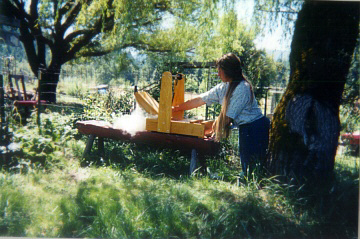 |
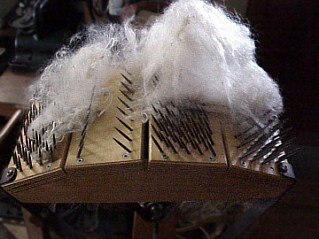 |
Here, after carefully washing the fleece with biodegradable soaps and fastidious rinsing so that no soap remains (with special attention paid to temperature) with a final soak in cream rinse, the fleeces when dried are "picked" or fluffed so that they can be further processed with the sample carder. The instrument Alexandra is shown with above is a "picker." If there are loose particles of hay or stray burrs in the fleece, this helps to remove them along with separating the fiber without tearing its long staple length.
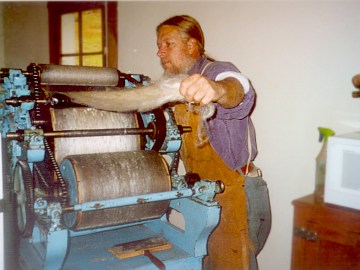
Important to keep the beard out of the works
Tools of the trade: The large machine is called a sample carder and is rather old (circa 1920). This vintage machine was built to last and still runs well. It is the heart and soul of the mechanized segment of production. For years we processed mohair for spinning by hand carding. It was a serious bottleneck in productivity. Now I am able to prepare large amounts of mohair batt for Alexandra to spin. She finds that to be a very accommodating. The "picked" mohair (see picker already shown) is then slowly fed into the carding machine. The beautiful batts of mohair come off the machine as soft blankets and are spinnable. Carding makes the spinning much easier to create a uniform handspun strand thus making the yarn produced by it a smoother character.Before the picked mohair is carded it is sprayed with carding oil (a mixture of lecithin, olive oil and water) to aid in the process.
As you can see this is really a "cottage industry". Our living room over the years has often been filled to the brim with sacks of mohair, baskets of yarns, weavings, hides, horns, and other assorted products from the herd. Below the batts of carded mohair pile up for Alexandra's skillful hands to spin. At any given time any number of projects can be going at once right in the center of the room. Even when outside work demands our attention there will be at least three spinning wheels and a couple of jack looms in the heart of the house. We are thankful that our back yard is over 64,000 acres of national forest to roam around in when it gets cramped inside :)
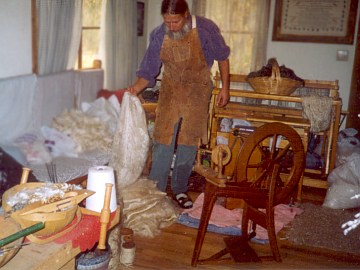
THIS is our actual living room!
Our Natural Fiber Cottage Industry
After the fleece is carded and the fibers are aligned for spinning the painstaking task of creating yarns is under way. This task requires a tremendous amount of discipline and care. Hundreds and hundreds of feet of single strand homespun fiber are then double plied to form a beautiful yarn that becomes the warp and weft of our mohair throws. The yarns have the true age old texture and quality of homespun.
The handspun yarns are lovely in their own right. Because they are not machined, their unique natural looking texture and handle is clearly visible. Fiber artists especially covet handspun, even if it is only an additional "accent" to enrich a garment made with otherwise machined yarns. We will gladly spin custom orders - you choose the color (natural dyes or chemical dyes). Don't forget that we have many natural colored mohair fleeces to choose from too!

Alexandra by the cottage
Not all yarns are for sweaters. For example, a rug yarn would have to be spun thickly and possibly single ply. And if you would like to accent your knitted or woven product, mohair can be spun into intriguing NOVELTY yarns, full of the halo, curl and character it is known for. These novelty yarns are oftentimes single ply, also. The yarns come in a broad spectrum of grades ranging from kid to very fine adult - all from our spinners' herd of angora goats. Our yarns are priced according to their weight and the grade of the fiber. Kid hair is most prized and precious since it is super fine and comes in much smaller quantities, but the adults of our spinners' flock have very fine micron fiber suitable for garments.
A typical knitting or weaving yarn spun to medium thickness (2 ply 4 oz. skein) would run approximately 45 yards per oz. or 1700 feet. A 4 oz. skein of kid hair would be $16.00. Larger orders of ten skeins or more would be discounted 10%. We would be glad to send samples of our homespun to you if you send us a large self addressed stamped envelope with $3.00 enclosed. A price list will also be sent along with the samples.

Skeins of natural colored mohair
The Weavings
After approximately 9 four ounce skeins of double ply yarn are spun, the yarn is then hand dyed or left natural to our specifications. The loom awaits Alexandra's skillful hands. Each design is charted out and the loom is warped. After weaving, unique mohair throw is examined and given any final touches that are needed. The entire piece of art takes approximately 3 weeks to complete. Each one has been a satisfying accomplishment. Our shepherding efforts culminate in a fine heirloom product fashioned for the most part in the time honored tradition of all our forefathers. (See the woven items in Alexandra's Weaving Gallery.)
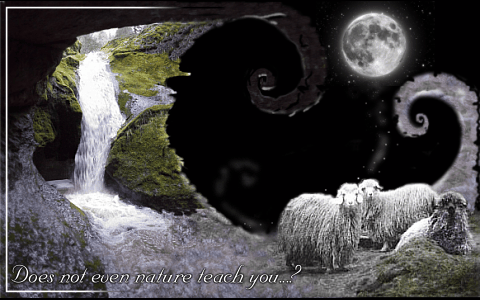
Angoras watching in the night
![[the singing falls waterfall]](images/alpha/singing_falls.gif)
![[singing falls logo text]](images/alpha/singingfalls_headmast.jpg)
![Capella the shepherd star with the kids, Hoedus I, Hoedus II and Al Anz [capella, the goat shepherd's constellation]](images/alpha/capella.gif)



